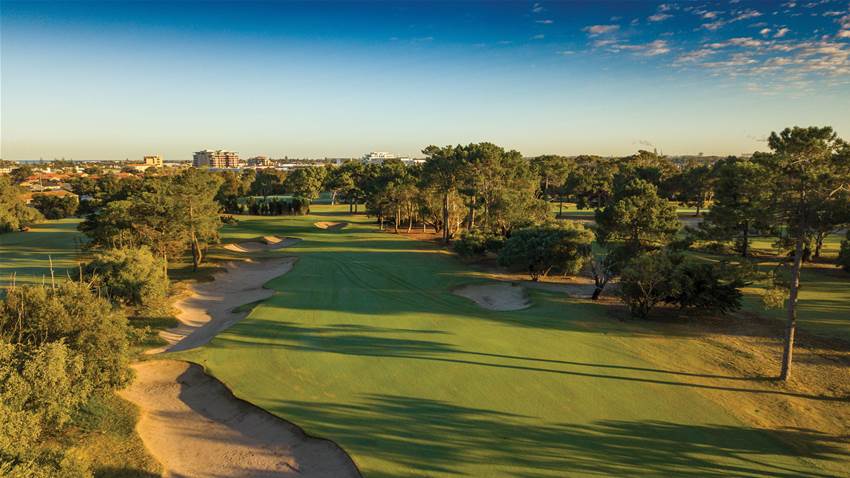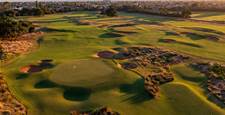The world’s best female golfers will descend on the ‘City of Churches’ this month to contest the ISPS Handa Women’s Australian Open at Royal Adelaide Golf Club. If you’re planning to be there, take your clubs and sample some terrific courses while you’re in town.
THE VALLEY
The heart of the Barossa Valley, is about 70 minutes’ drive from the Adelaide CBD. There you will find ample opportunities to combine a love of good food, wine with a round of golf on a fun course.
The town of Tanunda is at the heart of the region and just a few kilometres from town you will find the Novotel Barossa Valley Resort and the adjoining Tanunda Pines Golf Club.
The Tanunda course, which was purchased by a syndicate of some of Australia’s best known local vignerons, has improved its design and presentation markedly in the past 15 years. Several holes were redesigned, greens replaced, bunkers added and all the fairways converted to Santa Ana couch.
For mine the newest holes – the 10th, 11th, 14th, 15th, 17th and 18th – are Tanunda’s best offerings, with the downhill par-3 11th and the 460-metre par-5 15th being memorable standouts.
The 335-metre par-4 10th hole features a narrow fairway and plays uphill to a smallish putting surface, protected by two large bunkers – one short and right, with a deep sandy pit cut into the left fringe of the green. Missing this green here is likely to result in a bogey. Having putted out, you continue to climb uphill to the highest point on the course and the 11th tee.
The par-3 11th measures 180 metres from the back pegs, while the green lies 45 metres below the level of the tee. This can make club selection tough, especially into the prevailing headwind.
Tanunda Pines has started to realise its enormous potential and is a great place to soak in the views of the valley, walk fairways lined by massive gums and leave the city far behind.

Tanunda’s nearest golfing neighbour is Sandy Creek Golf Club (formerly Gawler Golf Club), which is the oldest club in the area and dates back to 1904 when it was a nine-holer next to the river near the centre of Gawler.
Golf has been played on the current site since 1965 but it is only in the past few years that the layout has been widely acclaimed for its quality, especially since a major redesign in the late 1990s.
There is a lot to like about Sandy Creek, which covers varying terrain from dramatic to relatively flat. There are some steep slopes and these have been used to create some good holes, with the uphill par-3 4th being the first of them. It’s a 174-metre one-shotter with a narrow, two-tiered green demanding correct club selection and precise ball-striking.
The 4th is the first of a stable of very good par-3s at Gawler. If you drop a shot at No.4, you will have a chance to get that shot back with a solid pitch shot at the 117-metre 6th. For such a short hole, played even shorter because of the highly elevated tee position, the green here is massive. Bunkers ring the putting surface so the best play is to the middle of the green and you might just get close.

The 6th marks the start of a very good sequence of holes that feature modern green complexes and an interesting use of the natural landscape. For mine the best, and most memorable of these holes, is the 405-metre 10th, which has been allowed to blend in with the natural landscape. Large dunes encroach on the fairway from the right and about 150 metres from the green, where the fairway is only a few metres wide for 40 or 50 metres or so. It’s quirky, and probably unfair for higher handicappers, but I really like it because it’s different and makes the hole more memorable.
THE HILLS
When the people of Adelaide want to get away from the city life, they don’t have to go too far to find an idyllic retreat.
You can be in the heart of the Adelaide Hills within 30 minutes’ drive east of the CBD. And once you’re there, you feel like you could be hundreds of miles away from the capital. But from its highest points, the city is right there below you.
The region is famous for the quality of its food and wine, with lots of cellar doors scattered throughout the Hills, producing some excellent cool climate wines.
There are also some fabulous golf courses where you can test your game.
Mt Osmond Golf Club is one of the oldest in the Adelaide Hills having been formed in 1927. Edward Holden – founder of Holden cars – was the inaugural president and the club quickly established a reputation among Adelaide society as the perfect weekend getaway to a country club.

Today, Mt Osmond is a well-manicured challenge having been extensively redesigned by Tony Cashmore, who has created high ranking layouts like Thirteenth Beach and the Henley course at The Heritage in Melbourne. The reconstruction of the course was completed in 1997, with large rolling putting surfaces and visually imposing bunkering elevating the test and enjoyment on offer.
Mt Osmond, by nature of its location, mixes holes with dramatic elevation changes with several easier walking holes that have been terraced into the edge of the sloping topography.
The trio of holes that complete the front nine are memorable for their visual appeal as well as the challenge they present. Perhaps the most striking is the 275-metre par-4 7th, which holds no surprises as the tee sits high above the wide fairway. If, like me, the thought of hitting a driver somewhere down near the green appeals, go for it. But there are two bunkers left and right of the slight dogleg left that are difficult to escape from and ensure a bogey is a good score.
Heading deeper into the hills, you will discover the picturesque Blackwood Golf Club, just 25 minutes’ drive away. While the club dates back nearly 90 years, it wasn’t until 1961 that golf was played on the current site on a layout created by Vern Morcom. Six holes on the back nine were changed in the early 1990s by designer Tony Cashmore.

The closing quartet of holes might just be the strongest in South Australia, outside of the Adelaide Sandbelt. But it is the 15th and 16th holes that you will long remember.
The 475-metre par-5 15th yields as many birdies as it does bogies (and worse). The hole turns slightly right-to-left passed the largest dam on the course and for those seeking to shorten the hole, they’ll need to skirt the edge of the hazard to put the green in reach for two shots. The real fun comes in the second half of the hole. The green is set into a hill with a second dam and deep bunker protecting the front left of the putting green, which also features a false front to the right.
A short climb up the hill behind the green leads you onto the tee of the 16th hole – a 398-metre par-4 sharp dogleg left around the dam that fronts the previous green, making it play much shorter than the scorecard suggests. Players who can carry their tee shots 200 metres from the back pegs, can hit across the corner of the dogleg to leave a mid-iron into the narrow and deep green. There is a large bunker left and two smaller pots right, where it is preferable to leave your approach shot, as long of the green will see your ball finish at the bottom of a steep slope.
After demolishing a double bacon and egg roll and coffee while overlooking the course from the clubhouse balcony, I took a scenic 15-minute drive west to Flagstaff Hill Golf Club.
Flagstaff Hill was built in the mid-1960s as part of a massive real estate development. In the years since, the complexion of the course has changed along the way. The landscape is set to change again with more residential development already underway.
The most memorable hole here is the club’s signature offering – the 144-metre par-3 8th hole, where the tee shot is all carry across the edge of a huge lake, named Loch Hilan. Obviously club selection is all-important to clear the water, but you also need to avoid three bunkers wedged between the water’s edge and the right side of the putting surface. If you err on the side of caution and take too much club, there is a deep trap beyond the green.
A further 10 minutes’ drive south and you will find The Vines Golf Club of Reynella, which boasts superb Santa Ana fairways and pure rolling bentgrass greens that are generally regarded as some of the best you will find in South Australia, outside the metropolitan area.

While the conditioning will impress, you will also enjoy the quality of the challenge. For mine, I really liked The Vines’ collection of par-3s. The first of them, the 149-metre par-3 3rd hole, is beautiful with towering 100-year-plus red gums surrounding the green. The canopy of the surrounding trees does come into play if you venture off line with your tee shot so accuracy is vital here.
The two back nine par-3s both play to elevated greens. The 145-metre 10th leads away from the clubhouse to a green where most of the front edge is guarded by a cavernous bunker. Club selection here is important as out-of-bounds is directly behind the green, so trying to avoid the bunker with a longer club could prove troublesome.
The shortest of the one-shotters is the uphill 14th. At 129-metres, it’s not a hole where length is the concern but with two bunkers either side of the entrance into the relatively small putting surface, it still pays to be straight.
After your round, I suggest you grab a cold drink and relax outside the clubhouse to take in the view of the course and its red gum lined fairways. The sound of Eastern rosellas feeding and chirping away in the treetops gave me the impression of being deep in the bush, but in reality all this was just 30 minutes from the CBD.
Offering a similar bushland experience is Thaxted Park Golf Club, an easy 10 minutes’ drive away.
Like its nearest neighbour, Thaxted Park’s first few decades after opening in 1964 were a constant battle for water. But four on course dams and an agreement with the local council provides enough water these days to ensure the playing surfaces are first class.
Course architects Neil Crafter and Paul Mogford of Golf Course Strategies have come up with a masterplan for the course, which predominantly involves widening fairways, creating new fairway bunkers, moving and remodelling some greens as well as some tees.
One of Thaxted Park’s most picturesque and memorable holes comes late in the round. The 15th hole is just 107 metres from the elevated tee down to the relatively small green that lies just beyond a creek bed. There is a bunker long of the green that comes into play more often than you might expect, while real beauty of this hole is the amphitheatre setting of the green and the gum trees that surround it.
In many respects this diminutive hole encapsulates everything that is enjoyable about playing golf in the Adelaide Hills – there is a typical Australian beauty about all of them, while the challenge is stern without being brutal.
Related Articles

Review: Omaha Beach Golf Club

Drinks With... Ricky Ponting












